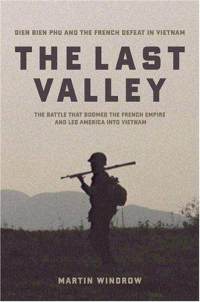
The Last Valley
Martin Windrow
734 pages including index
published in 2004
Dien Bien Phu is the battle which as The Last Valley‘s front cover blurb succintly puts it, “doomed the French empire and led America into Vietnam”. An European army, equipped with the most modern weaponry it could field and superior in firepower was defeated by a peasant guerilla army in exactly the sort of standup fight all the experts said such a guerilla army could never win. It was proof that France could never win this war and all it could do now was withdraw with honour. At the same time Dien Bien Phu was both the proximate cause for the United States to get itself deeper involved in Vietnam as well as a terrible warning, a warning that was not heeded, that its involvement would not be succesful. Finally, for those so inclined, it was yet more proof of France’s inherent incompetence at waging war, the way its army allowed itself to be caught in a trap and destroyed. For all these reasons Dien Bien Phu is one of the few post-war battles that have stayed in the general public’s consciousness.
Which doesn’t necessarily mean that this image of the siege is accurate of course. As The Last Valley shows, Dien Bien Phu wasn’t a trap the French just blundered into, but part of a deliberate strategy to get an elusive guerilla enemey to stand down and fight. It was a strategy that had worked before and had been designed to make the most of the limited resources the French forces in Vietnam had available. Because unlike the Americans after them, the French neither had the money nor the men or material to go after the Viet Minh, so had to find some way to get them out where they could be got at. Dien Bien Phu wasn’t lost because the French were dumb or cowardly, but because the Viet Minh were smarter, had prepared better and had learned from their experiences at earlier battles.